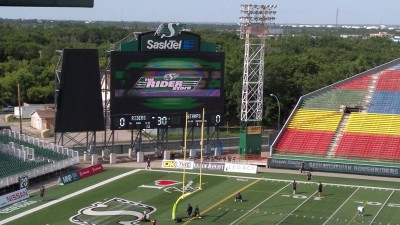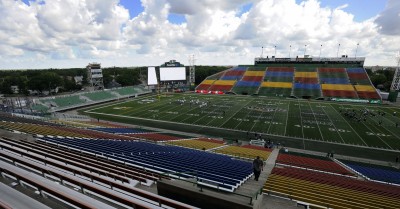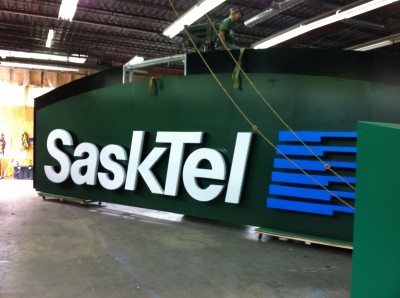By Anthony Kilgallen
During a major sports event, spectators may be forgiven if, while peering up at the scoreboard, they do not happen to wonder how the massive structure was put together. Amid the constant distractions of the game, vendors, advertisements and crowd atmosphere, chances are their attention is focused elsewhere. The scoreboard is simply a tool that provides part of the total fan experience.
There are others, however, who have a different outlook with regard to the ever-growing sports and entertainment industry. Some signmakers have found a niche within the industry by specializing in incorporating custom signage into sports venues’ scoreboard structures.
Jim Hotten, for example, is president of Ottawa-based Signs.ca, a relatively small company that has produced large-scale signage projects, including scoreboards for such stadiums as Ottawa’s Scotiabank Place, Regina’s Mosaic Stadium—where the Sasktel Maxtron scoreboard is part of the Grey Cup Legacy Project—and Michigan State University’s (MSU’s) renovated Spartan Stadium in East Lansing, Mich.
Led by production manager Paul Hallett, the Signs.ca team works out of a 929-m2 (10,000-sf) shop; but what they lack in size, they hope to make up for in project management and attention to detail.
Mosaic Stadium
In February 2012, a $14-million renovation plan began to move ahead to revive Regina’s aging Mosaic Stadium at Taylor Field, home to the Canadian Football League’s (CFL’s) Saskatchewan Roughriders. Fans had been promised new seating, new concessions and a new state-of-the-art scoreboard with multiple high-definition (HD) light-emitting diode (LED) displays. It was a massive job to undertake at the time, with the 2012 football season looming closer, including the 100th Grey Cup Championship.
With thousands of Roughriders fans waiting during the off-season, a whirlwind of activity took place at Mosaic Stadium. The iconic venue was given its much-needed facelift in time for the beginning of the football season in late June.
The stadium’s old Maxtron scoreboard was replaced in the northeast end zone with the new Sasktel Maxtron screen. At 7.9 x 18.3 m (26 x 60 ft), the new sign is more than twice as large as its predecessor. It is accompanied by a secondary 11.3 x 4.3-m (37 x 14-ft) LED screen that is to be used strictly for sponsorship purposes, thus freeing up the larger display for greater fan-oriented interaction.
Signs.ca added the finishing touches to the custom-designed structure and built a 4.6 x 16.5-m (15 x 54-ft) ‘centrepiece’ façade to perch atop the two massive video boards. The company worked over a three-month period alongside Icon HD, which specializes in audiovisual (AV) project management and consultation, and Panasonic, the manufacturer of the screens, to ensure the client’s design benchmarks were met.
With a sleek signage and backer design, Signs.ca’s portion of the scoreboard project included a set of 1.8-m (6-ft) tall LED-illuminated channel letters, a 2.7 x 5.5-m (9 x 18-ft) Saskatchewan Roughriders logo with 330-mm (13-in.) returns and a layered backer panel to hold all of the elements together. After the structure was built in Ottawa, it was shrink-wrapped in a protective coating, loaded onto a wide trailer and shipped more than 2,500 km (1,553 mi) to Regina.

The project team spent a week installing and testing the various components. After the Roughriders’ training camp, the scoreboard made its public debut in June 2012.
To achieve the desired level of illumination for both the team logo and the channel letters, it was necessary to first build the channel cans with aluminum, then create formed polycarbonate faces with clear 102-mm (4-in.) returns. By doing so, a glowing effect was achieved, which can be seen as soon as the sun sets over Mosaic Stadium.
The backer panel and structure that hold the logo and letters were constructed in such a way that each piece would fit together seamlessly. This made the installation of these components a one-step process, as a crane was able to hoist the signage in once piece and fasten it to the existing steel scoreboard framework.
That framework was completed just before the signs arrived. The project team then spent roughly a week installing the components and testing them to make sure everything was in working order, with no hiccups.
The new Maxtron screens were used during the Roughriders’ training camp to show hopeful players inspiring video footage of their die-hard fans showing support and offering motivation for the upcoming season.
Finally, on June 22, 2012, the Roughriders kicked off their home opener against the Calgary Stampeders. It was a close game, but even though Regina’s team lost 33-31, fans left the renovated stadium with a new feeling of pride in their team and its home.







